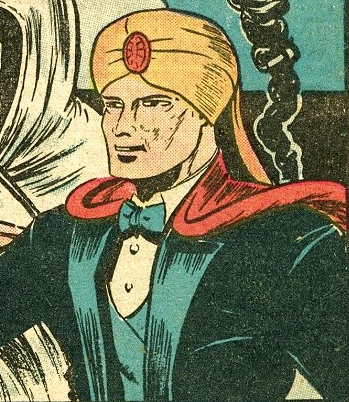Yarko The Great, Master of Magic was created by Will Eisner in 1939 for publisher Victor Fox‘s Fox Feature Syndicate as the main feature in the 2nd and final issue of Fox’s Wonder Comics. How that came about is more interesting than the character itself.
In 1939 things were heating up in the nascent comic-book industry. A year earlier, from National Periodicals, there appeared on the newsstands ACTION COMICS #1 and with that the entire industry was changed. Lee Falk’s new comic-strip MANDRAKE THE MAGICIAN had debuted in the newspapers in 1934, and inside Action Comics #1 National featured their own knock-off of the character, Zatara The Magician: both were dolled up in dapper tuxedo finery, both looking like a less-ethnic Harry Houdini (who was born Erik Weisz, later Ehrich Weiss). As noted elsewhere, however, there was another model for comics magicians, the model of the Eastern-styled Mystic, someone who “Gained their mystical powers from the Secrets of The Mysterious East” or some such rubbish, usually following the solid example set by the wildly popular radio- and movie-serial character CHANDU The MAGICIAN. Will Eisner, a burgeoning comics creative powerhouse, was honing his skills for cheapskate publisher and newsrack-flooder Victor Fox, the self-proclaimed “King of Comics,” at whose behest Eisner had created the first Superman rip-off, Wonder Man, appearing in the 1st issue of Fox’s WONDER COMICS. The character didn’t last past that first issue, and the title itself didn’t last past the second issue, changing with the judgement in favor of National’s copyright lawsuit against Fox –which had already eliminated the Wonder Man character– forcing the title change to WONDERWORLD. But in that 2nd and final issue with the original title, Eisner created the early turban-wearing magician-hero YARKO THE GREAT, MASTER OF MAGIC which replaced the vanished Wonder Man as the title’s lead character for that single second issue. And while Eisner’s relation-
ship with Fox did not last (more fallout from the Wonder Man debacle, with Eisner testifying that Fox had indeed instruct him to rip-off DCs Superman character) the Yarko character limped onward in various Fox titles through 1942.
To be sure, the single most interesting thing –perhaps the only interesting thing– about Yarko is Eisner’s presence on the strip, and after the first 3 episodes, that was gone. (Eisner drew the first 2 and wrote
the first 3.) Without a steady guiding hand such as Eisner, Yarko never rose above being a mediocre character, poorly drawn and juggling various gimmicks — he needed to be able to see in order to cast his spells, he cast his spells by speaking backwards, and then he didn’t, the size of his turban changed from panel-to-panel (OK maybe that’s not a gimmick, that’s Fox’s lousy editorial control) – but after freeing himself from Fox, and after trying unsuccessfully to syndicate the strip overseas, Eisner re-tooled the character. turning it into his own MR. MYSTIC with Bob Powell, and the character had a long life in the
SPIRIT Section newspaper inserts Eisner had created.After Mr. Mystic, other turbaned comics magicians followed suit, including, most notably, Fawcett’s IBIS THE INVINCIBLE and Basil Wolverton’s remarkable MYSTIC MOOT AND HIS MAGIC SNOOT.
If for no other reason, and there really aren’t many, it’s amusing to watch how the Yarko character, and the strip’s never-fully developed style, change and mutate over the course of Yarko’s brief career as a back-of-the-book filler feature for Victor Fox’s funnybook empire..

